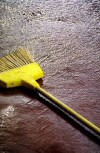
 Home |  Products |
 Print Page |  Back |
 Orders |  Shipping |
 Links |  Search |
 Contact Us Contact Us | |
 Distributor Information Distributor Information | |
 Contractor Directory Contractor Directory | |
 Link to Chargar Link to Chargar | |
 Add a Link Add a Link | |
 Shopping Cart Shopping Cart | |
960 Masonry Cleaner
960 Rust Remover is a special blend of acids,detergents and water soluble solvents to be diluted with water and used to remove rust stains from masonry surfaces.960 Rust Remover can also be used to remove rust stains from painted masonry surfaces without harming the paint. 960 Rust Remover removes rust stains caused by hard water,sprinkler systems,well water and other ferrous type stains.960 Rust Remover also removes stains caused by copper or brass. Simply saturate the surface with 960 Rust Remover,lightly scrub into surface and rinse with water. Rust stains will dissapear.
Masonry Cleaners

 960 Rust Remover
960 Rust RemoverRemoves rust from masonry.
 AC-3 Cleaner
AC-3 Cleaner
Safety acid cleaner.
 Muriatic Acid
Muriatic Acid
20% Professional Grade. Etches Concrete.
 Masonry Cleaner 700
Masonry Cleaner 700
Cleans mortar stains off new masonry work.
 H.D. 900 Restoration Cleaner
H.D. 900 Restoration Cleaner
A heavdy duty cleaner for carbon and other stubborn stains.
Area Glossary
- Masonry
- That which is built by a mason; anything constructed of the materials used by masons, such as stone, brick, tiles, or the like.
- John used a masonry cleaner to remove the rust stains around the water spigot. - Rust
- Any of various powdery or scaly reddish-brown or reddish-yellow hydrated ferric oxides formed on iron and iron-containing materials by low-temperature oxidation in the presence of water.
- Mortar
- Any of various bonding materials used in masonry, surfacing, and plastering, especially a plastic mixture of cement or lime, sand, and water that hardens in place and is used to bind together bricks or stones.
- The mason determined that the mortar must have been poorly mixed. - Muriatic
- Of, pertaining to, or obtained from, sea salt, or from chlorine, one of the constituents of sea salt; hydrochloric.
- Carbon
- A naturally abundant nonmetallic element that occurs in many inorganic and in all organic compounds, exists freely as graphite and diamond and as a constituent of coal, limestone, and petroleum, and is capable of chemical self-bonding to form an enormous number of chemically, biologically, and commercially important molecules.
-Limestone, one of the materials in concrete, contains carbon.
-Masonry cleaners, such as Chargar's Restoration cleaner, can remove carbon stains.
- Water traveled along the pipes leading into the basement causing rust stains to appear on the masonry.
-Muriatic acid is another name for hydrochloric acid.
